Lift Truck Technician Training: Behind the scenes
More than just the oil and lube guys, lift truck technicians must clear multiple hurdles to prove they are proficient at all skills needed to keep your fleet running. Here’s how they become so good at what they do.
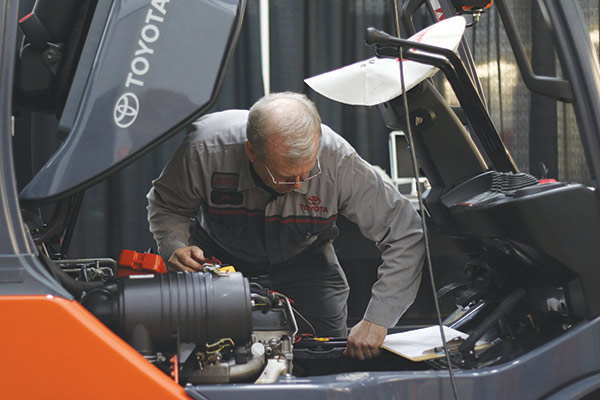
Look out across your facility for a minute. Focus on the lift trucks. Now, look at a couple of them individually.
Do you know which one needs some preventive maintenance this week? Or, which one is about to need an unexpected repair at the most inopportune time? Probably not. That’s why you rely on lift truck technicians—to keep all trucks up and running as optimally as possible.
But how exactly does that happen? How did these techs get in the game in the first place?
Materials Handling MRO wondered the same thing. So, we talked to four lift truck suppliers about their technician training programs to get an idea of how they make it possible for your fleet to stay up and running.
To say the least, lift truck technician training is a big deal. We talked to four—Crown, Raymond, Toyota and Yale—but all major suppliers have placed a heavy emphasis on training. Furthermore, they are all very proud of their programs—a fact that came across strongly in interviews.
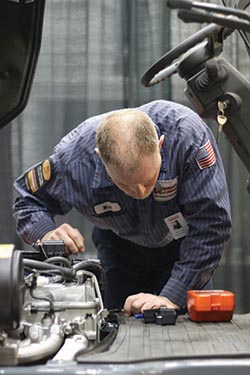 Training lift truck technicians well has implications not just for the techs themselves but for suppliers and their customers, too. The first step is to find the right people with promising skills that can be developed. But it’s not easy (see below). The next big challenge is to build a career path for techs that recognizes their mechanical, electrical and hydraulic, and soft skills.
Training lift truck technicians well has implications not just for the techs themselves but for suppliers and their customers, too. The first step is to find the right people with promising skills that can be developed. But it’s not easy (see below). The next big challenge is to build a career path for techs that recognizes their mechanical, electrical and hydraulic, and soft skills.
Interviews made it clear that lift truck suppliers spend big bucks to make all of this happen. No company would say exactly how much it spends annually, but it’s a significant commitment by all to employ training staffs at the corporate and dealer level. There’s also the matter of developing and managing training programs across the country, even globally.
“Many people don’t realize the investment needed to support a top-tier training initiative,” says Evelyn Velasquez-Cuevas, Yale’s director of training.
Or as Tom Lego, Toyota’s national manager of customer service and training, says: “Lift truck techs need to be more than the oil and lube guy.”
But lift truck suppliers don’t all go about training the same way. Different models are at play to get highly trained techs out on your facility floor.
Crown, for instance, has 18 regional training centers globally. In North America, Toyota and Yale make extensive use of centralized training centers in Columbus, Ind., and Charlotte, N.C., respectively. All suppliers we spoke with do some training at individual dealerships, too.
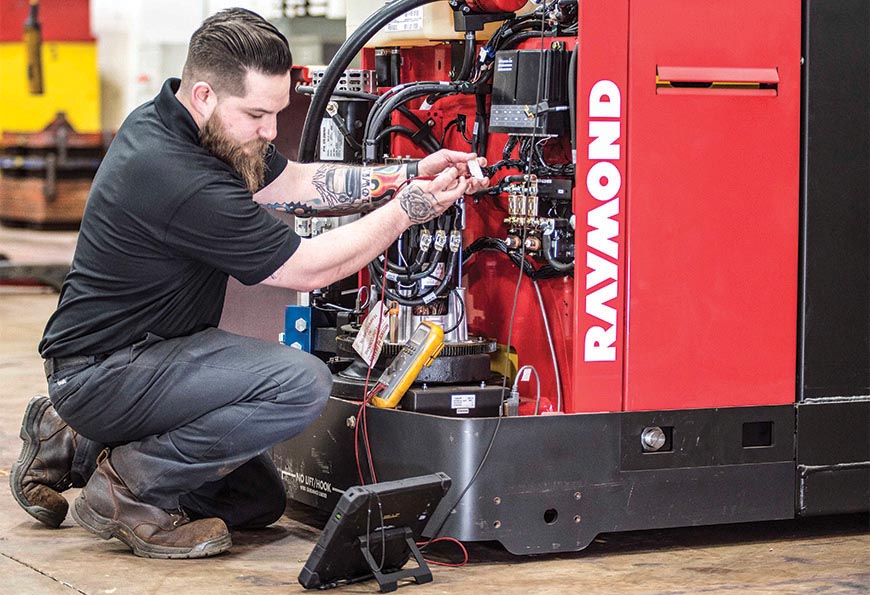
A combination of hands-on and electronic instruction guide the training process.
At Raymond, tech training is known as its Technical Development Program, explains Mike Ballas, technician development project lead. Its focus is on standardized training and continuous improvement of technician skills.
“We train to have a positive impact on service levels,” says Ballas. “We are focused on developing high competency levels and critical thinking skills,” he adds.
Justin Moore, Crown’s general manager of service training, says training maximizes the value of techs to customers and safety.
Nuts and bolts of training programs
Clearly, the days of traditional classroom training are long gone. Sure, some class work is done using traditional printed materials. But, that work is overshadowed by videos, animation and interactive e-learning programs, not to mention hands-on training on real equipment. Raymond, for one, is starting to explore virtual reality as an instruction tool.
“People learn in different ways,” Lego says. “Some are visual learners while others are auditory and tactile learners. We have to build our program to appeal to all learning styles. You can teach theory, but you need hands-on, too.”
Or as Velasquez-Cuevas says, “we deliver effective training by modeling the environment that techs will be working in. Eight hours of Powerpoint is not how people learn.”
Clearly, all four suppliers we talked to prefer a corporate-wide standardized approach to training and demonstration of skills to instructors. That said, each company has its own approach to teaching. Here are some of the more philosophical highlights from each.
Raymond prefers Socratic questioning to maximize critical thinking skills so techs ask the right questions up front.
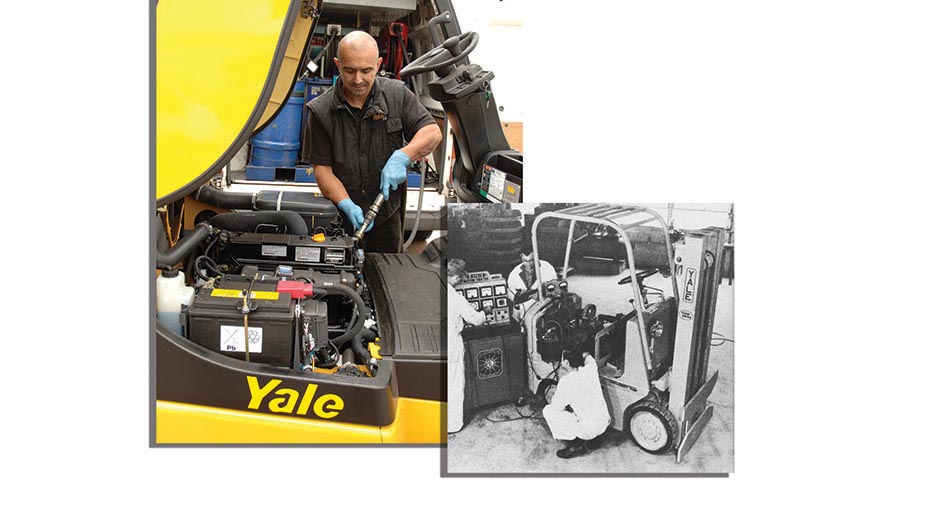
Throughout the years, lift truck technicians have been critical to keeping fleets up and running.
Yale emphasizes that training is a journey with multiple opportunities to improve techs’ responsiveness and flexibility.
Crown talks about building the confidence of its technicians, both new and experienced, in meeting new challenges.
Toyota sees its foundation for success as making technicians a partner to help customers.
Program structures
Building those programs requires corporate as well as dealer staff. One supplier has as many as 20 instructors on the corporate staff and another 70 at dealerships around the country. In at least one case, technicians spend a week a year at a non-dealer training location. Others prefer to localize the training at dealerships.
Crown and Yale offer a sense of training intensity throughout the year.
At Crown’s Atlanta regional center, says Moore, one regional service trainer and two service training instructors are on staff. Class size is limited to 12. When all eight of the U.S. regional training centers are combined for the scheduled 46 weeks of the year, it results in 2,300 to 2,400 seats of training.
Yale’s Velasquez-Cuevas says corporate staff annually receives nearly 100 requests from its 38 dealers for three to five days of training.
So how do suppliers train instructors up to meet such demand?
A train-the-trainer model is popular. In this scenario, corporate trainers train instructors who are located at specific dealerships. Sometimes, they meet face-to-face annually while others are less frequent.
Behind the scenes: Lift truck technician training
An open letter from Evelyn Velasquez-Cuevas, Yale’s director of training
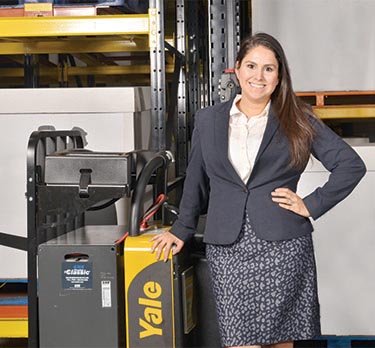 For all the discussion about technical labor shortages, the collective corporate and educational community has been slow to react. Ironic, that in a world characterized by faster delivery, increased automation and greater complexity, the skilled labor it requires is in critically short supply.
For all the discussion about technical labor shortages, the collective corporate and educational community has been slow to react. Ironic, that in a world characterized by faster delivery, increased automation and greater complexity, the skilled labor it requires is in critically short supply.
We can solve this as an industry. Addressing a problem of this magnitude requires all hands on deck, and it needs to happen now. Education and business communities cannot wait for the other to take action. We all must work to find candidates earlier than ever, and supply the training and mentorship to support them.
As an industry, we need to market technician roles as the critical, desirable career paths they are. Likewise, high schools and vocational schools must provide technician programs with tracks designed for industries in need of their graduates. Such a solution sets everyone up for success.
There also has to be a constant stream of communication between the corporate training lead and instructors at all levels. All lift truck companies introduce new models on a regular basis and update those that are already in the field.
Keeping that communication flowing requires the lead to meet with engineering and product people as well as others to know what has changed, communicating that to trainers and technicians. That, of course, requires updates to training materials. Printed materials as well as webinars, podcasts and face-to-face meetings are used.
The heart of lift truck tech training is for the newbies. Each supplier has its own path that differs in terms of how content is grouped, organized and sequenced. Needless to say, all cover mechanics, hydraulics and electrical. Timelines differ, too, but hands-on demonstrated proficiency is common to all programs.
For instance, Raymond breaks training down to three phases, says Ballas. A technical primer provides the foundation knowledge. Scheduled maintenance issues follows. The third phase is troubleshooting and repair. There are more than 90 modules in total, Ballas adds.
Crown uses a five-week onboarding program for all new technicians, which includes safe work, planned maintenance, troubleshooting foundation and customer communication. This is in addition to the 40 hours of training a year for all Crown technicians at a regional training center, which is completed individually with hands-on equipment.
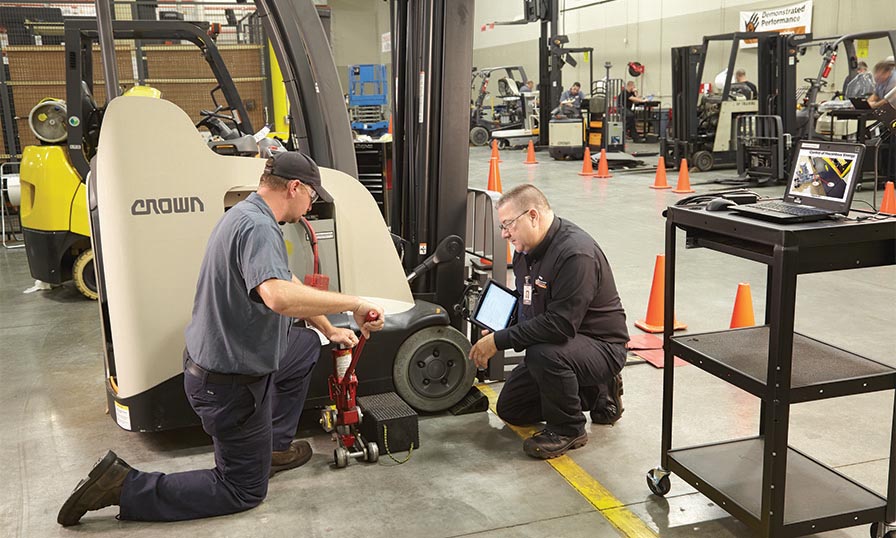
Some technicians are visual learners while others are auditory or tactile learners. Training programs accommodate all learning styles.
As was said earlier, all require hands-on training. Typically, a student performs a skill under the watchful eye of an instructor who then decides on the level of proficiency. If it is lacking, the student repeats until standards are met.
Not all of training is confined to the truck itself. Development of soft skills in the technician is a top priority these days. “Customer relationships are as important as maintaining the truck,” says Ballas.
Then there’s the question of how techs are recognized for their level of overall proficiency. That differs widely by supplier.
Toyota, for instance, divides it into several segments. To begin, the intent is to train the tech to do proper preventive maintenance (PM) and routine servicing of trucks. The next level is called bronze and goes beyond PM to include troubleshooting and repairs. Lego says Toyota expects half of its new techs to be at this level at the end of two years.
Next is the silver level. Here, a tech begins to specialize by truck model. After about five years, is the gold level—a deeper dive on all of previous proficiencies. About 10% of techs, says Lego, achieve the platinum level. This requires an annual re-certification.
“All of those who reach the platinum level are eligible to be considered to compete in an annual skills challenge to be named the top tech of the year,” continues Lego. “We want to celebrate not only those who have achieved that level but recognize the best of the best.”
When it comes to the big picture of these training programs, Lego puts it best. “Training lift truck techs is about life-long learning. The more they learn, the more they can help customers.”
Companies mentioned in this article
- Crown Equipment
- The Raymond Corporation
- Toyota Material Handling
- Yale Materials Handling Corporation

Article Topics
MRO News & Resources
Avidbots showcases autonomous cleaning robots Traka exhibits modular lockers MRO Survey: Finding and keeping the best technicians Maintenance, Repair and Operations: Understanding the true condition of the equipment Newly formed Bison combines AMETEK DFS and Bison Gear and Engineering Corp. Building (and maintaining) your maintenance, repair and operations (MRO) tech workforce The power side of lift truck battery and charger maintenance More MROLatest in Materials Handling
Geek+ and System Teknik deploy PopPick solution for pharmacy group Med24.dk Beckhoff USA opens new office in Austin, Texas Manhattan Associates selects TeamViewer as partner for warehouse vision picking ASME Foundation wins grant for technical workforce development The (Not So) Secret Weapons: How Key Cabinets and Asset Management Lockers Are Changing Supply Chain Operations MODEX C-Suite Interview with Harold Vanasse: The perfect blend of automation and sustainability Consultant and industry leader John M. Hill passes on at age 86 More Materials HandlingSubscribe to Materials Handling Magazine

Find out what the world's most innovative companies are doing to improve productivity in their plants and distribution centers.
Start your FREE subscription today.
April 2024 Modern Materials Handling

Latest Resources










